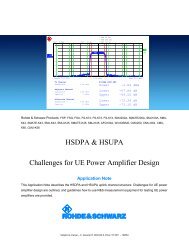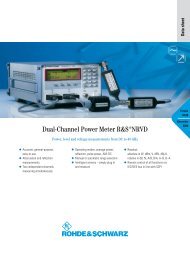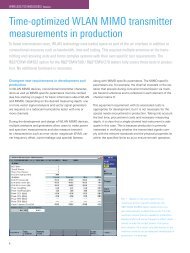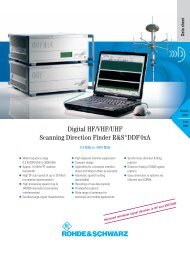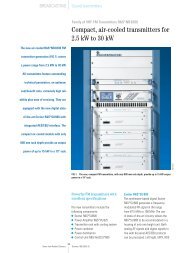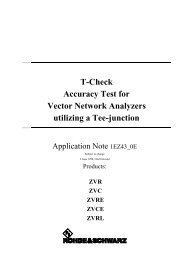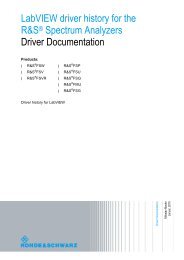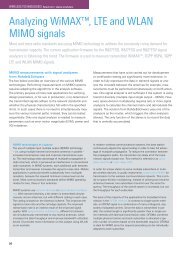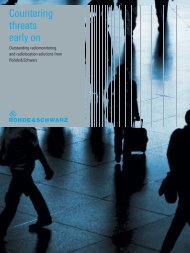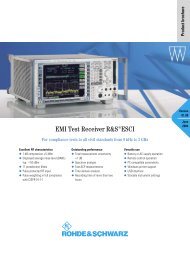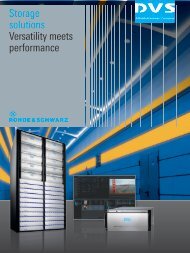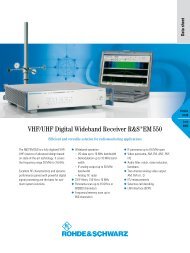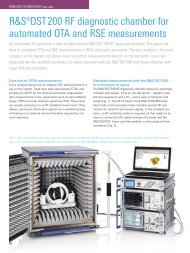English - Rohde & Schwarz
English - Rohde & Schwarz
English - Rohde & Schwarz
You also want an ePaper? Increase the reach of your titles
YUMPU automatically turns print PDFs into web optimized ePapers that Google loves.
proposed by Operators Harmonization<br />
Group (OHG).<br />
Up to four base stations or four mobile<br />
stations with separately selected scrambling<br />
code can be simulated. One BS<br />
may have up to 128 data channels in<br />
addition to special channels. An MS<br />
can be operated in the three modes<br />
PRACH only, PCPCH only and DPCCH<br />
+ DPDCH (max. 6 DPDCHs).<br />
Symbol rate, channelization code,<br />
power (can even be varied in time)<br />
as well as data contents and timing<br />
offset can be selected for each code<br />
channel (timing offset can be used to<br />
infl uence signal statistics and thus crest<br />
factor).<br />
P-/S-CPICH, P-/S-SCH, P-/S-CCPCH,<br />
AP-/CD-AICH, PDSCH, DL-DPCCH and<br />
DPCHs with their corresponding slot<br />
structure can be generated in the downlink.<br />
Transmit diversity is also already<br />
supported. The clipping function allows<br />
simple simulation of the clipping measures<br />
implemented in every base station.<br />
Despite the large functionality of this<br />
option, W-CDMA signals can be generated<br />
fast by means of assistant functions.<br />
A W-CDMA signal is produced<br />
by a few keystrokes with the aid of<br />
predefi ned confi gurations, which may<br />
be varied through selection of the crest<br />
factor or the number of data channels.<br />
To avoid incorrect entries, overlapping<br />
of individual code channels<br />
(domain confl icts) can be displayed<br />
and even automatically resolved by<br />
a keystroke (FIG 3). The graphical<br />
display of constellation diagram, CCDF<br />
and occupied code domain serves to<br />
check generated signals for conformance.<br />
And this can be done far more<br />
easily than with an analyzer.<br />
Oversampling is digital, so long signal<br />
lengths can be implemented (eg 13<br />
frames with 3.84 Mchip/s), which<br />
allows much more realistic signals to be<br />
generated than by continuous repetition<br />
of the same frame.<br />
FIG 2<br />
Section of mixed<br />
GSM/EDGE signal<br />
generated with<br />
SMIQ (slots 1 and 3<br />
contain GSM burst,<br />
slot 2 EDGE burst)<br />
MAG<br />
Ref Lvl<br />
10 dBm<br />
• Generation of mixed GSM/<br />
EDGE signals<br />
• Creation of multichannel,<br />
random confi gurable W-CDMA<br />
signals to 3GPP and power<br />
control of individual W-CDMA<br />
channels in realtime (with<br />
option B45/B48)<br />
• Measurement of BER (with<br />
option B21)<br />
• Optional two-channel arbitrary<br />
waveform generator<br />
The new modulation coder enhances<br />
SMIQ by additional options and by<br />
various improvements:<br />
• Maximum permissible symbol<br />
rate of 18 Msymbol/s, unrivalled<br />
and future-safe<br />
• Amplitude shift keying (ASK)<br />
and split-phase fi lter are<br />
implemented. The special feature<br />
of this fi lter is that it generates<br />
Manchester-coded signals.<br />
These are signals where each<br />
symbol is represented by a<br />
dB<br />
T1<br />
10<br />
–90<br />
0<br />
The new functions at a glance<br />
Articles<br />
CF 890.2 MHz Meas Signal<br />
SR 270.833 kHz Magnitude<br />
Standard GSM<br />
SYMBOLS 514.75<br />
signal change, ie the symbol<br />
adopts two states per symbol<br />
clock. Together with ASK modulation<br />
for example, this selfclocking<br />
code allows generation<br />
of signals for the Japanese<br />
ETC system (electronic toll collection)<br />
that is currently being<br />
developed<br />
• Memory for storing user-specifi c<br />
modulation data per option<br />
can be extended up to max.<br />
80 Mbits<br />
• Improved resolution of digital fi lters.<br />
As a result, SMIQ can now<br />
achieve ACP values of –74 dB<br />
with TETRA standard<br />
• The number of available fi lters<br />
was extended, the permissible<br />
range of their parameters widened<br />
and combination of fi lters<br />
with any modulation allowed. It<br />
is thus possible to simply simulate<br />
many applications outside<br />
the major standards<br />
News from <strong>Rohde</strong> & <strong>Schwarz</strong> Number 166 (2000/I) 11



